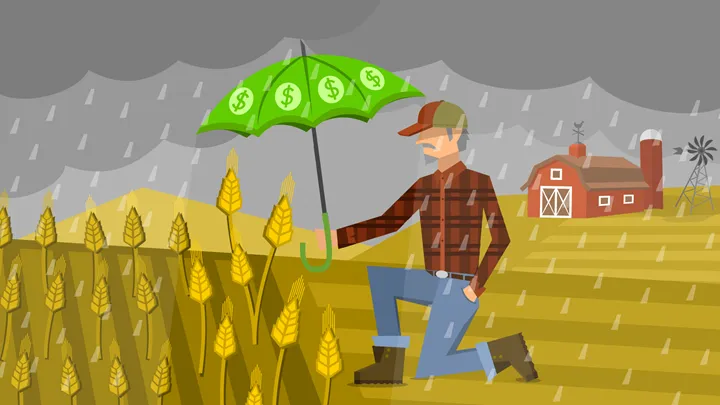Agriculture insurance is a crucial component of modern farming, designed to protect farmers from the financial risks associated with unpredictable and often harsh weather conditions, pest infestations, and other unforeseen events. In an industry where margins can be razor-thin and risks can be high, having the right insurance coverage can make a significant difference in a farmer’s ability to sustain and grow their business. This article explores the importance of agriculture insurance, the different types available, and how farmers can choose the best policy to meet their needs.

What is Agriculture Insurance?
Agriculture insurance refers to policies specifically tailored to safeguard farmers and their crops or livestock against various risks. These policies help mitigate losses from events such as droughts, floods, diseases, and accidents. By transferring some of the financial risks associated with farming to an insurance provider, farmers can focus more on their agricultural operations and less on the uncertainties that come with them.
Types of Agriculture Insurance
1. Income Protection Insurance
Purpose: Provides compensation for lost income due to reduced crop yields or livestock production.
- Revenue Protection Insurance: Combines coverage for both yield loss and price decline. It protects against reductions in revenue due to lower yields or falling market prices.
2. Fertilizer and Chemical Insurance
Purpose: Covers losses related to the application of fertilizers and chemicals.
- Fertilizer and Chemical Loss Insurance: Provides coverage if fertilizer or chemicals cause damage to crops or soil, or if there is a financial loss due to issues with these inputs.
3. Forestry Insurance
Purpose: Protects against losses related to timber and forest operations.
- Timber Insurance: Covers damage to standing timber due to fire, pests, or other covered perils. It ensures financial compensation for timber losses.
- Forest Management Insurance: Covers losses related to the management of forested areas, including reforestation and logging operations.
4. Nursery Insurance
Purpose: Provides coverage for nurseries growing plants, shrubs, and trees.
- Nursery Crop Insurance: Covers losses due to adverse weather, pests, diseases, or other perils affecting nursery plants. It helps protect the investment in growing and maintaining nursery stock.
5. Greenhouse Insurance
Purpose: Covers risks specific to greenhouse operations.
Greenhouse Crop Insurance: Covers losses to crops grown within greenhouses due to adverse conditions, such as temperature extremes or power outages.be particularly costly.
Greenhouse Property Insurance: Protects greenhouse structures and equipment from damage due to fire, wind, or other covered perils.
Why Agriculture Insurance is Essential
Agriculture insurance plays a crucial role in safeguarding the livelihoods of farmers and ensuring food security. It provides financial protection against various risks associated with farming, which can be unpredictable and devastating. Here are several reasons why agriculture insurance is essential:
1. Financial Protection
Insurance provides a safety net against unexpected losses, ensuring that farmers do not face insurmountable financial burdens. This protection helps maintain financial stability and supports recovery efforts after a loss.
2. Risk Management
By transferring the financial risks associated with farming to an insurance company, farmers can better manage and plan their operations. This approach allows them to focus on improving productivity and efficiency rather than worrying about potential losses.
3. Access to Financing
Many financial institutions require insurance coverage as a prerequisite for providing loans or other forms of credit. Having adequate insurance can, therefore, enhance a farmer’s ability to secure financing for expansion, equipment, or other investments.
4. Support for Recovery
In the aftermath of a disaster or significant loss, insurance provides the necessary funds to repair, replace, and resume operations. This support is vital for returning to normalcy and ensuring long-term sustainability.
Choosing the Right Agriculture Insurance Policy
Selecting the right insurance policy can be complex due to the variety of options available. Here are some key considerations for farmers:
1. Assess Your Needs
Determine the specific risks your farm faces and the type of coverage that best addresses those risks. Evaluate factors such as crop types, livestock breeds, and regional climate conditions to choose the most suitable insurance policies.
2. Compare Policies
Compare different insurance policies and providers to find the best coverage and value. Look for policies that offer comprehensive coverage, reasonable premiums, and reliable claims support.
3. Understand Policy Terms
Carefully review the terms and conditions of each policy, including coverage limits, exclusions, and the claims process. Ensure that you fully understand what is covered and any potential gaps in coverage.
Conclusion
Agriculture insurance plays a vital role in protecting farmers from the financial uncertainties inherent in farming. By understanding the different types of insurance available and carefully selecting the right policies, farmers can safeguard their livelihoods and ensure the sustainability of their operations. Investing in agriculture insurance not only provides financial security but also contributes to effective risk management and recovery planning, ultimately supporting the long-term success of farming enterprises.